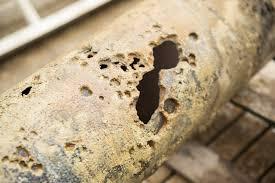What does copper corrosion mean?Copper corrosion or copper rust refers to the chemical reaction that occurs when copper and copper alloys comes into contact with certain substances or environmental conditions, leading to the deterioration or degradation of the copper surface. It is a natural process that can affect the appearance, integrity, and functionality of copper materials over time. Early stages can show a reddish brown cuprous oxide layer. Copper alloys are known for their excellent corrosion resistance, but it is not entirely immune to corrosion. Various factors can contribute to copper corrosion, including exposure to moisture, oxygen, acids, salts, pollutants, and other corrosive agents. The corrosion process typically involves the formation of copper oxide or copper sulfate compounds on the surface of the copper, which can manifest as discolouration, tarnish, or the formation of greenish-blue patina. The severity and rate of copper corrosion depend on several factors, including the type and concentration of corrosive substances, temperature, humidity, and the presence of other metals or alloys in contact with the copper. In some cases, copper corrosion can lead to the degradation of mechanical properties and structural integrity, compromising the performance of copper-based components or systems. It can also lead to reduced electrical conductivity across electrical contacts. Managing corrosion potentialHowever, it is important to note that copper corrosion can be managed and minimised through various preventive measures. Protective coatings, such as lacquers or clear sealants, can be applied to copper surfaces to provide a barrier against corrosive elements. Regular cleaning and maintenance can also help to remove contaminants and prevent the buildup of corrosion-inducing substances. In summary, copper corrosion refers to the deterioration of copper surfaces due to chemical reactions with corrosive agents or environmental factors. Understanding the causes and implementing appropriate preventive measures can help preserve the appearance and functionality of copper materials over time. Types of copper corrosionThere are several types of ways that copper corrodes depending on the specific circumstances and corrosive agents involved. Here are some common types of copper corrosion: Uniform Corrosion: This type of corrosion occurs evenly across the metal’s surface, as seen below on this copper pipe (or copper tube), resulting in a general thinning or degradation. It typically happens when copper is exposed to moist or acidic environments over an extended period.

Pitting Corrosion: Pitting corrosion is characterised by the localised formation of small pits or craters on the copper surface. See below corroded copper pipes. It is often caused by the presence of chlorides or other aggressive ions, and it can lead to the formation of deep holes, compromising the integrity of the material.

Crevice Corrosion: Crevice corrosion occurs in confined spaces or crevices where stagnant solutions can form, preventing the access of oxygen and promoting the accumulation of corrosive agents. It can manifest as localised corrosion around fasteners, gaskets, or joints. - Galvanic Corrosion: Galvanic corrosion arises when copper comes into contact with dissimilar metals in the presence of an electrolyte, forming a galvanic cell. The more reactive metal corrodes, while the copper may experience accelerated or localised corrosion.
Dezincification: Dezincification is a specific form of corrosion that affects brass, an alloy containing copper and zinc. In dezincification, the zinc component of the brass corrodes preferentially, leaving behind a porous copper structure that can lead to loss of mechanical strength.

Intergranular Corrosion: Intergranular corrosion occurs along the grain boundaries of the copper material, usually due to sensitisation caused by improper heat treatment or exposure to certain environments. It can result in a weakening of the copper structure. Stress Corrosion Cracking: Stress corrosion cracking is a phenomenon where the combination of applied stress and a corrosive environment leads to the formation of cracks in the copper material. It can occur under specific conditions, such as exposure to certain chemicals, in particular ammonia compounds, or high temperatures.


These are just a few examples of the types of copper corrosion that can occur. Each type has distinct characteristics and mechanisms, and preventing or managing corrosion requires understanding the specific factors contributing to it and implementing appropriate preventive measures. Effects of copper corrosion and oxidisationIs copper easily corroded?Copper is known for its excellent corrosion resistance compared to many other metals. It is considered a noble metal, meaning it is less prone to corrosion than metals lower in the electromotive series. Copper’s inherent corrosion resistance is due to its ability to form a protective oxide layer on its surface, which acts as a barrier against further corrosion. Under normal conditions, copper is relatively resistant to copper corrosion by atmospheric elements, such as moisture and oxygen. This resistance makes copper suitable for various applications, including plumbing systems, electrical wiring, roofing, and decorative elements. However, copper can still corrode under certain circumstances and in the presence of specific corrosive agents. Factors such as exposure to acidic or alkaline solutions, high humidity, saltwater environments, and industrial pollutants can accelerate the corrosion of copper. Additionally, interactions with dissimilar metals, known as galvanic corrosion, can also affect copper. It’s important to note that the extent and severity of copper corrosion depend on several variables, including the specific environment, temperature, duration of exposure, and the presence of other factors that can promote or inhibit corrosion. To mitigate corrosion and maintain copper’s integrity, various preventive measures can be implemented. These include applying protective coatings, such as sealants or lacquers, using corrosion-resistant alloys or coatings for specific applications, and employing proper design and maintenance practices. In summary, while copper has good inherent corrosion resistance, it is not entirely immune to corrosion. Understanding the specific environmental factors and taking appropriate measures can help preserve copper’s integrity and extend its lifespan. Below is an extension table showing the resistance to many elements and compounds: |






